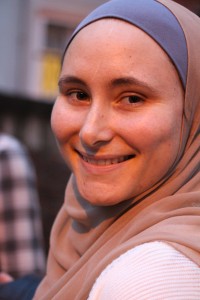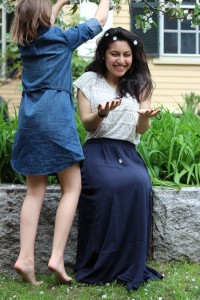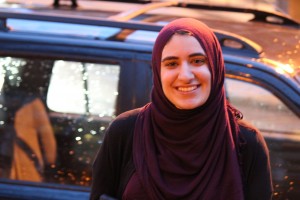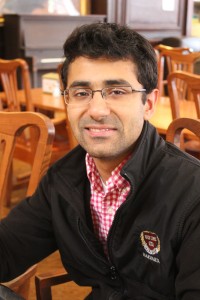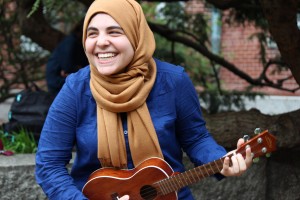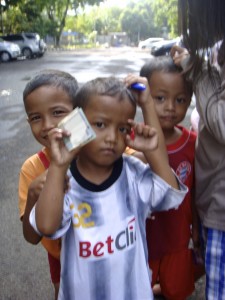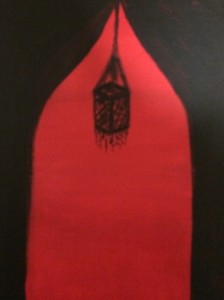Prologue
Posted in Uncategorized on May 13th, 2014Please read this prologue for an introduction to my blog!
The six pieces of art I created through the course of the semester are incredibly different. A burning piece of parchment, the arch of a building in the setting sun, the hands of a beggar, a whirling dervish and a pop art piece on a woman wearing a hijab. One may ask, and appropriately so, how are any of these pieces connected to one another? What is their unifying theme? They all seem to portray completely different ideas or aspects of Islam. The unity between the pieces comes from the fact that there is almost no explicit connection between them, though each piece individually connects to Islam. The question that arises, and the question my final piece of art, a series of portraits of Muslims at Harvard, asks is “Whose Islam?” These pieces of art act as a reminder of the complex and multifaceted nature of Islam. The ultimate message my portfolio should convey is that there is no one unified Islam with one definite truth, however connections can exist between different Islams on a much broader level.
My portfolio should be viewed with two important understandings. The first is that the topics and themes discussed in my artwork were introduced through the cultural studies approach. The second is that I am a Muslim in the process of questioning my own faith, and my pieces were definitely influenced by my own religious journey. Viewing Islam through the cultural studies approach takes into account the surrounding contexts that allow for different interpretations of Islam and the ensuing practices stemming from those understandings to evolve. Culture, history, politics, conflict, the effects colonization, economic crises, and a plethora of other factors were taken into account when looking at the different parts of Islam. Using this style of study enabled me to see many faces of Islam I had never seen before or beliefs I once thought to be absolute heterodoxy. At times this lens allowed for me to study Islam as though I was not a Muslim. Certain concepts were viewed from a purely anthropological standpoint as it was the first time I was exposed to these practices; however when creating my artwork I reevaluated the information from my own understanding of Islam. The development of many of my pieces came from a conflicted attempt at reconciling the idea of multiple or collective truths. I came into the class with an understanding that many different interpretations of Islam existed; however I also believed an ultimate truth existed, though I may not have known the truth myself. I had no issue admitting that my interpretation of Islam could be wrong, for I was and continue to question my own faith. What was more troublesome was the idea that there might not be a definite right of wrong after all and that there are in fact multiple truths coexisting at once – the batin might not be a singular entity.
My first blog post was a response to a Swahili piece on Prophet Muhammad’s journey and ascent to heaven. A significant portion of the writing was designated towards creating the fiery image of hell, something that bothered me deeply. My artistic response was creating a painting of the word haram burning. My artwork seems in some ways to be an objective response to the Swahili writing, providing no explicit commentary on the nature of their hell or what were considered to be sacrilegious practices, but no artwork is truly objective. My piece showed the word haram burning but my burning question was “what is truly haram?” I found the writings to be incredibly one sided, focusing heavily upon the sins of women that landed them in hell and only briefly discussing a few men and their punishments. Though I had some reservations about this portion of the writing, the larger conflict arose from my belief that God is truly omnibenevolent and to be loved my his creations, and what I perceived to be fear mongering in this piece. With this being said I once again had to return to the realization that this is someone’s Islam and this individual has every right to believe in its truth.
Another piece that echoed my internal conflict was the drawing of the hands of a beggar receiving money from a wealthy individual. I believe zakat to be a very private affair dedicated to the greater cause of alleviating poverty in the world. However, in Aminata Fall’s piece, the Senegalese characters treat zakat like a business transaction. It was a circular process in which the poor were needed to pray for the rich and the rich would have to donate money to the poor so that they would pray for the rich. My response was a satirical piece fueled by a degree of frustration with this understanding of zakat that Fall also seems to criticize. I drew a wealthy individual, whose hands were adorned with rings, giving a very small amount of money to a poor individual with nothing. In my mind, the amount of money the affluent individual donates is close to nothing when compared to their true wealth and I reduce their actions to nothing more than a narcissistic display of self righteousness. Once again my frustration can be contextualized through my interpretation of Islam, which maintains that we should not practice the rituals of Islam to show others but rather to commit ourselves to the principles these rituals represent.
Both of these pieces reflect two incredibly different aspects of Islam and furthermore show very different interpretations from those of my own. Though I may not agree with these particular views, they both illustrate the fundamental point my blog posts are attempting to present – whose Islam are you looking at? It was an incredibly taxing experience to recognize the legitimacy of views that were so fundamentally different from my own, especially when my views were shaped by a completely different culture and time period.
Unlike my response to zakat and the Swahili text, my paintings of the arch in the setting sun and the whirling dervish are not critical of the practices. In my view both the dervish and arch attempt to capture the intangible greatness or presence of God. The painting of the arch is based on the idea that the architecture and designs used within a mosque are very purposeful. They have not only practical and aesthetic purposes but are dedicated towards creating a feeling of greatness. This particular piece was shaped largely by my own experiences at certain mosques and the sounds of the athan reverberating across the walls, high ceilings, and columns. The literal echo emphasized the enormity of the mosque and how it surrounds those worshipping within the structure. In a more symbolic sense it captures the omnipresence of God.
The dance of the dervish is a completely different entity, and yet I found parallels between this form of art and the religious expression of Islamic architecture. The dance, like many spiritual practices of Sufism, is a way of becoming completely consumed in the act of worshipping of God. It acts almost as an out of body experience where the worshipper has committed themself to something outside and greater than their own worldly being. Some Sufis would consider these moments to be euphoric incidents of experiencing or even meeting God.
At the surface these two practices and forms of art are incredibly different. In fact they are quite fundamentally different from one another. Dance is a dynamic physical movement of the body whereas a building and its design are static and permanent works of art. Both, however, address the idea of feeling God’s presence. This is a prime example of how one practice or concept can be interpreted in incredibly different manners.
My final two pieces touch more explicitly on the existence of multiple Islams. One of my artistic responses was to the lecture on women and Islam. My particular response focused on the veil or hijab. The topic of the hijab can be rather sensitive and one’s opinion of the hijab varies greatly based upon whom you speak to. Certain women will speak against wearing the hijab. Others might feel that they can still practice Islam without wearing the hijab, though they do not feel strongly against the hijab. Some women feel liberated by wearing the hijab. Some women feel oppressed by forces not permitting them to wear the hijab and feely express themselves. Numerous other complex relationships exist between a woman, modesty, and her religion. This one aspect of Islam really demonstrates the plurality of perspectives and also highlights consequent conflicts. The existence of multiple perspectives, when it comes to modesty, has led to a lot of debate. Certain individuals attack others for not living a modest lifestyle; these individuals judge others based upon their own understanding of modesty in Islam. The debate has expanded to included government in countries such as Turkey. The hijab was considered by some individuals to be anti-western and a source of delay in the modernization of the country.
My final piece was a series of portraits of different Muslims throughout the Harvard community. The goal of the photo series was to capture different interpretations of Islam. The portraits were not necessarily serious and formal. In fact I encouraged people to have fun with their poses and what they wanted to say. The people I chose to photograph had different experiences with Islam and this was reflected in their responses of the conversations I had while photographing them. Both the photo project and the response to the women and Islam really hammer in the idea that one unified Islam does not exist. But the question I hope these blog posts will inspire is how do you live with these multiple pluralities?
The greatest challenge is learning to live and adapt to these pluralities – coexistence. The fact that someone may have interpreted the Qu’ran in a manner completely different from your own interpretation can be a very destabilizing experience. In the real world this realization is an absolute reality one must face. How can one stay true to their own faith while accepting the existence of other beliefs? Does accepting the existence of other beliefs delegitimize one’s own beliefs? The cultural studies approach treats all interpretations equally and breaks down the evolution of certain practices. Personally, studying different practices and finding clear cultural roots and social constructs leading to the development of rituals and beliefs was incredibly scary as it in some ways took the holiness out of the practice. The fear came from applying the same lens to my own beliefs and seeing if they too could be broken down. More importantly I had to decide whether this should even change my beliefs. If one were to magnify my experience by the number of Muslims and the numerous different interpretations, they could see how striking these interactions between Islams can be.
In my opinion co-existence is a very important goal in life. I hope that readers enjoy my blog posts and that these posts were truly able to convey the diversity of Islam and I also challenge readers to think of ways to encourage co-existence.
